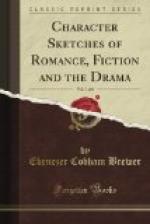Dowlas (Old Dame), housekeeper to the Duke of Buckingham.—Sir W. Scott, Peveril of the Peak (time, Charles II.).
DOWLING-(Captain), a great drunkard, who dies in his cups.—Crabbe, Borough, xvi. (1810).
DOWNER (Billy), an occasional porter and shoeblack, a diffuser of knowledge, a philosopher, a citizen of the world, and an “unfinished gentleman.”—C. Selby, The Unfinished Gentleman.
DOWNING, PROFESSOR, in the University of Cambridge. So called from Sir George Downing, bart., who founded the law professorship in 1800.
DOWSABEL, daughter of Cassemen (3 syl.), a knight of Arden; a ballad by M. Drayton (1593).
Old Chaucer doth of Topaz tell,
Mad Rabelais of Pantagruel,
A later third of Dowsabel.
M. Drayton, Nymphida.
DRAC, a sort of fairy in human form, whose abode is the caverns of rivers. Sometimes these dracs will float like golden cups along a stream to entice bathers, but when the bather attempts to catch at them, the drac draws him under water.—South of France Mythology.
DRA’CHENFELS ("Dragon rocks"), so called from the dragon killed there by Siegfried, the hero of the Niebelungen Lied.
DRAGON (A), the device on the royal banner of the old British kings. The leader was called the pendragon. Geoffrey of Monmouth says: “When Aurelius was king, there appeared a star at Winchester, of wonderful magnitude and brightness, darting forth a ray at the end of which was a flame in the form of a dragon.” Uther ordered two golden dragons to be made, one of which he presented to Winchester, and the other he carried with him as a royal standard. Tennyson says that Arthur’s helmet had for crest a golden dragon.
... they saw
The dragon of the great pendragonship.
That crowned the state pavilion of the
king.
Tennyson, Guinevere.
Dragon (The), one of the masques at Kennaquhair Abbey.—Sir W. Scott, The Abbot (time, Elizabeth).
Dragon (The Red) the personification of “the devil,” as the enemy of man.—Phineas Fletcher, The Purple Island, ix. (1633).
DRAGON OF WANTLEY (i. e. Warncliff, in Yorkshire), a skit on the old metrical romances, especially on the old rhyming legend of Sir Bevis. The ballad describes the dragon, its outrages, the flight of the inhabitants, the knight choosing his armor, the damsel, the fight and the victory. The hero is called “More, of More Hall” (q. v.)—Percy, Reliques, III. iii. 13.
(H. Carey, has a burlesque called The Dragon of Wantley, and calls the hero “Moore, of Moore Hall,” 1697-1743).
DRAGON’S HILL (Berkshire). The legend isays it is here that St. George killed the dragon; but the place assigned for this achievement in the ballad given in Percy’s Reliques is “Sylene, in Libya.” Another legend gives Berytus (Beyrut) as the place of this encounter.




